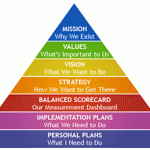 We explore the centrality of distilling, understanding, consistently adhering to and communicating your core mission in every aspect of strategic planning and project implementation. Nadine B. Hack, beCause President, has advised organizations and individuals from different sectors – business, non-profit, government – for over three decades. Regardless of what need or problem they initially ask for assistance in resolving almost always they have a more comprehensive need or larger problem than the specific issue they originally think. Most often, key stakeholders of organizations – regardless of their size, length of time in existence or level of sophisticated expertise – lack a clear jointly-shared grasp of and commitment to their core mission.
We explore the centrality of distilling, understanding, consistently adhering to and communicating your core mission in every aspect of strategic planning and project implementation. Nadine B. Hack, beCause President, has advised organizations and individuals from different sectors – business, non-profit, government – for over three decades. Regardless of what need or problem they initially ask for assistance in resolving almost always they have a more comprehensive need or larger problem than the specific issue they originally think. Most often, key stakeholders of organizations – regardless of their size, length of time in existence or level of sophisticated expertise – lack a clear jointly-shared grasp of and commitment to their core mission. Then, whenever we do a thorough analysis of drilling deep into why they do what they do and connect that to the purest most central vision of their aspirations, we unearth, extract and reveal their core mission. In some cases everyone implicitly already knew what it was but never had an explicit distillation of it. In others cases, we found that while people thought they were on the same page in fact they actually held wildly different views about their core mission. Either way, making clear what was murky or unarticulated then provides the framework against which everything else can be evaluated.
Does what we are doing, planning for or considering in any other area of our work advance our core mission? If so, how can we do more of that even more effectively? Conversely, does it distract us from achieving our core mission or even just pull us slightly off track? If the former, we should not be doing it at all, as it deters us from fulfilling our core mission; if the latter, we should make the adjustments needed to be aligned with our core mission. There are more questions we ask: Which elements of our core mission are absolutely inviolable so regardless of changing circumstances we would never abandon them? Which might be specific to a goal that if we achieve it or the need for it no longer exists, we could and possibly should modify as not all aspects of core mission are static?
Once you start operating from this core mission-centric, core mission-driven modus operandi, the guidelines for every decision and possible activity becomes clearer. Whether yours is a for- or a not-for profit organization, the first internal step is to get all on your team – from the CEO, COO, CFO, other senior managers and staff to the board and any other key stakeholders in your operation – to understand, agree with and abide by your core mission. Ideally, to reach this highly functional state, you engage all of those people in the process of formulating your core mission. This greatly increases the likelihood that they will be guided by it. The alternative approach of a small senior group – or worse, one individual like the CEO or board chair – making the decision and handing it down by fiat is less effective as true buy-in and ownership of your core mission by your full team is critical for its success.
The second external step is articulating your core mission in a clear, concise and simple to understand way to your target audiences and key constituencies, starting with your most important ones: with not-for profits, your funders, grantees, volunteers and interns; with for-profits, your investors, shareholders, clients, vital sub-contractors and service providers; for government, your executive and legislative colleagues, those you serve locally (if you are municipal or state), nationally (if you are federal) or internationally (if you are part of the United Nations system or with an Overseas Development Agency); for all three, your partners, allies and consultants, then moving on to the media and larger public. Far too many core mission statements are verbose: actually laundry lists of your strategies, tactics and activities, not your distilled core mission. Ideally, as many of your internal stakeholders should engage in the process of drafting, editing and revising your core mission statement until your entire team feels you’ve reached an accurate and clear articulation of your core mission. You should include someone who is a skilled professional wordsmith, whether it is your internal communications director or an outside PR specialist who works with you during this distillation process to help craft the crispest, easy-to-grasp, most effective final wording of your core mission.
You also can consider asking for feedback from your external stakeholders that are your most important target audiences and key constituencies starting with partners and allies: if you are a non-profit do your funders, grantees, volunteers and interns share your view of your core mission? If you are a for-profit do your clients, investors, shareholders, subcontractors and service providers understand your core mission? If you work in government do those you serve understand your core mission? Not-for profits definitely should avoid the pitfall of being donor-driven (i.e.: changing or modifying your core mission to meet the desires of a specific donor, a huge mistake made all too often by nonprofits). For-profits don’t want to be driven by a rogue shareholder with a completely different perception of your core mission. Governments have to manage citizen expectations of what you can deliver realistically given your core mission. But, if handled with appropriate boundaries and politically-sensitive insight, regardless of which sector, you actually might discover through the insights of any one of your external target audience and key constituencies a golden nugget of truth about what your core mission is that you missed even though you went through such a rigorous internal process.
Unfortunately, some more dictatorial or territorial leadership styles don’t allow even for the type of internal collaboration – let alone opening it up to anyone from the “outside” – I’m recommending and in fact they are threatened by it. This is frustrating when you know you and others on your team have something valuable to contribute. At that point, you have some important personal choices to make: how long do you try to change the culture and ethos of your work environment? Can you learn to tolerate working in an environment that doesn’t value your insights? What is your breaking point where you are so dispirited you should leave? I realize that the last option in the current economy is a tough choice. But, at least try to be honest with yourself about where you stand so that if after you’ve tried everything, you’re still miserable and the economy changes for the better, you are ready for a possible move.
The third ongoing step is that you have to keep reminding your internal stakeholders, external target audiences, key constituencies and the larger public of what your core mission is. Every single decision, action and communication must be one that supports and advances your core mission. You can easily slip away from it if you are not vigilant. Whether a start-up or an entity with a long history, without this clarity of your core mission, your staff, board, shareholders, clients, investors, subcontractors, volunteers, those you serve, those who fund or advise you, support you as advocates, partner with you on projects or anyone else at the least will have difficulty making decisions and taking actions that advance your core mission and at the worst can be pull you off your core mission: I’m sure you’ve all experienced “scope creep.” But, making “mission-driven, mission-centric” your mantra will make your mission work!

